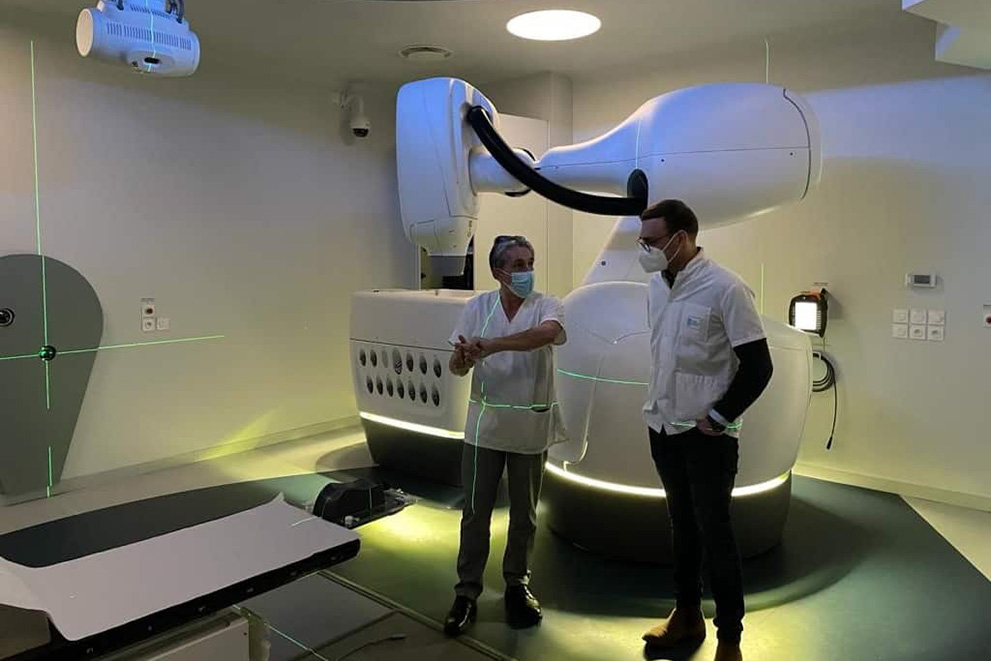APOLLO lasers ensure precise, repeatable patient positioning in the treatment room
The APOLLO laser system from LAP helps the medical physics team to prioritize patient safety while streamlining the radiation oncology workflow
Find the original article on the Physics World website.
Patient safety, patient throughput and patient experience: these are the clinical reference points informing the development roadmap for the APOLLO laser system from LAP, the German laser and radiotherapy QA specialist. With around 3000 units shipped annually to radiation oncology clinics worldwide, APOLLO lasers are nothing if not pervasive, ensuring accurate, repeatable positioning of the patient versus the linac isocentre to enhance the safety of radiation delivery while streamlining the radiotherapy workflow. Equally significant, APOLLO lasers represent a core enabling technology for manufacturer-independent quality assurance (QA), ensuring precise orientation of the phantom and its ancillaries in a range of testing set-ups for patient, machine and end-to-end radiotherapy QA checks.
“After treatment planning via CT or MRI simulation, the patient is positioned on the linac treatment couch,” explains Raphael Schmidt, LAP’s product manager for CT, MR and linac laser systems. “The APOLLO source’s ultranarrow laser lines then project the linac isocentre coordinates onto the patient’s skin, allowing for alignment with millimetre accuracy against the planning CT/MR image, while also ensuring reproducibility throughout successive fractions of a high-precision radiotherapy programme.”
Operational flexibility, it seems, underpins the APOLLO product design versus key clinical pain points, including: enhanced and ergonomic patient accessibility for the radiation therapist; efficient positioning and rotation of the patient in bore-type linacs; improved interaction (with more eye contact) between patient and therapist; as well as clear demarcation between the patient positioning and treatment steps.
That flexibility extends to the in-room installation, with various possibilities for combining wall-, ceiling- or floor-mounted APOLLO laser units. Different attachment systems and adjustable retainers allow LAP to adapt the laser system to the specifics of the customer’s treatment room and linac set-up. Further, the APOLLO system has three lasers for the coronal, sagittal and transversal body planes, while an optional fourth laser prevents possible shadowing from the linac gantry.
For the medical physics team, the principal motivation for deploying APOLLO lasers is to optimize the machine and workflow ergonomics in the treatment room – in effect, creating the conditions for streamlined patient positioning at scale. A case in point is the alignment of larger patients on the treatment couch prior to irradiation in a bore-type linac – for example, Varian’s Halcyon and Ethos treatment systems. “With the help of APOLLO lasers,” notes Schmidt, “the therapist can lift and rotate the patient in an ergonomically friendly position before the treatment couch enters the bore – after which any repositioning becomes cumbersome and time-consuming. Our clinical customers tell us that lifting the patient in this way makes it easier to go for the last millimetre in terms of positioning accuracy.”
On a day-to-day basis, meanwhile, APOLLO lasers enhance the radiotherapy workflow and minimize the requirement to reposition the patient after the cone-beam CT (for image guidance). “Efficient and accurate patient positioning helps to maximize patient safety and minimize the need for reimaging, delivering sustained time savings for the treatment team,” claims Schmidt. “It’s a win-win, with patients receiving high-quality radiotherapy fractions on schedule and clinics hitting or exceeding their throughput targets.”
The clinical upside
If that’s the vendor perspective, what of the view from the clinical sharp-end? Stéphane Muraro, a senior medical physicist at the Centre de Cancérologie du Grand Montpellier (CCGM), France, is an enthusiastic advocate of LAP lasers for patient positioning, having installed APOLLO laser units alongside the clinic’s Varian Halcyon treatment machine as well as its Accuray CyberKnife robotic radiotherapy system.
For Muraro and colleagues, the APOLLO lasers have yielded significant – and sustained – efficiency gains when setting up patients for treatment in the Halcyon system. “We use APOLLO lasers to ‘pre-install’ the patient outside the linac bore, enhancing both patient safety and patient throughput,” he explains. “After all, if you get the patient positioning right on the treatment couch outside the bore, you can be very sure of their positioning inside the bore of the machine.”
All of which translates into a “friction-free” radiotherapy workflow at CCGM, with typically 15-minute slots allocated for the positioning and treatment of each patient on the Halcyon system. “The APOLLO lasers help us to position the patient correctly first time, every time,” says Muraro. “This also improves the patient’s experience in the treatment suite by minimizing the stress resulting from delays and repeat positioning. Ultimately, the more relaxed the patient, the better they are able to hold their position and the better the treatment outcome.”
APOLLO’s broader benefits
Those APOLLO gains also extend to the daily QA on the Halcyon machine, including the use of an imaging phantom to verify the system’s image-guided radiotherapy (IGRT) functionality – specifically, the alignment between treatment and imaging geometries as well as the accuracy of the couch adjustments. “Regarding the daily QA, the first task with Halcyon is to install the phantom at the start of each day,” notes Muraro. “The physicists can then make a ‘double verification’ of positioning with the APOLLO laser and Halcyon’s internal laser. It’s easier to position the phantom and QA devices using the external lasers, aligning the phantom exactly as you would align the patient.”
Looking ahead, Muraro and the CCGM medical physics team are keen to scale their deployment of APOLLO lasers. “The APOLLO lasers are extremely reliable, resistant to scattered radiation and easy to adjust via remote controller as needed,” he concludes. “We plan to install the APOLLO lasers on our two Varian C-arm linacs in the next couple of years.”
For further information, see the on-demand webinar "Lasers making a difference in patient alignment: CT and LINAC solutions from LAP".

